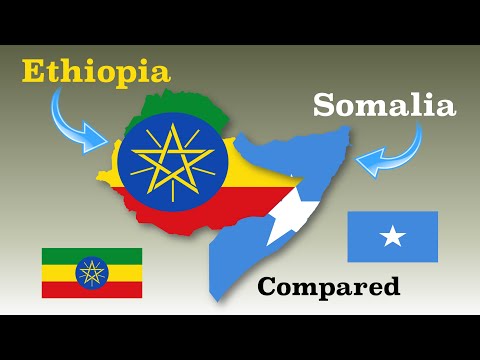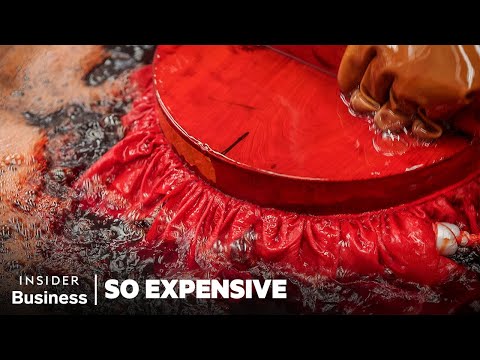Ethiopia and Somalia Compared

Ethiopia and Somalia or...officially the Federal Democratic Republic of Ethiopia and the Federal Republic of Somalia Two bordering countries in the Horn of Africa, which is the part of Africa that looks like, ya know, a horn. It’s not only a peninsula, but considered a geopolitical region, with around 140 million people. Ethiopia and Somalia are the two largest countries in the Horn of Africa, along with Eritrea and Djibouti, which will likely be a future video for this series, by the way. Hey speaking of this series, there’s this guy named Fredo Rockwell who has a YouTube channel called…Fredo Rockwell, and he is straight up MOCKING this series on that channel. Yeah! It’s messed up. More on that in a bit. Anyway, as a kid watching the world news, I remember watching reports coming out of both countries, and every report seemed filled with despair, whether it was from war, famine, or environmental catastrophe. Even today in the United States,
there is this negative stereotype of these two countries, but after researching both, I can confidently tell you these stereotypes are just plain wrong. First, let’s look at what both countries have in common. Both are among the fastest growing countries in the world. At current rates, Ethiopia’s current population will double in the next 30 years and Somalia’s population will double in the next 25 years.
The capital city in both is also the biggest city in both. And the names of both cities are so fun to say. Mogadishu and Addis Ababa. Both are members of the African Union and the United Nations, and both have expressed interest in joining the East African Community. Somalia’s also a member of the Arab League. Both have generally young populations, but the median age is lower in Somalia. (E- 19.5, S- 16.7) Both are becoming quickly urbanized. Both have authoritarian-leaning governments. While both countries are technically “republics,”
according to the organization Freedom House, both are two of the least free countries in the world due to their citizens having hardly any political rights and civil liberties. That said, this is getting better in Ethiopia, and Somaliland, which does not consider itself to be part of Somalia, is a glaring exception. Freedom House gives Somaliland a freedom score of 49 out of 100 compared to just 7 out of 100 for Somalia. Residents of both speak several different languages. The official languages of Ethiopia are Afar, Amharic, Oromo, Somali, and Tigrinya, but Harai and Sidama are also spoken in certain areas. The official languages of Somalia are Somali,
Arabic, English, and Italian. More than 80 languages are spoken in Ethiopia. Although this is quickly changing in Ethiopia, agriculture is still a dominant industry in both. Both were among the earliest lands to be settled by humans. Yeah, let’s get into some history…come on let’s do this.
Yeah, some of the earliest human fossils have been found in modern-day Ethiopia, with some dating back to more 230,000 years ago. That’s uh, that’s a few years longer than we’ve all been alive, I think. Agriculture began in the Horn of Africa between 3,000 and 6,000 years ago. During the Egyptian Empire, scholars note of a mysterious kingdom called the Land of Punt, in which parts of modern-day Ethiopia and Somalia were in. There was also the ancient kingdom of D’mt (yeah that’s how it’s written ok?), but honestly we don’t know much about it.
After the fall of D’mt in the 300s BC, modern-day Ethiopia splintered into smaller kingdoms, but by the first century AD, the notable Kingdom of Aksum was now a thing. The Hebrew Bible mentions the Queen of Sheba, who got with King Solomon and had a son, Menelik, who went on to become the first king of Ethiopia. Now this is according to Ethiopian tradition, and there’s not much evidence this is how it actually went down. Regardless,
we do know that Ethiopia, as a country, is one of the oldest countries in the world, with it being around probably at least 2,000 years old. Christianity came to Ethiopia in the 300s, converting Ezana of Axum, the king dude who also is known for conquering and expanding the Kingdom of Aksum. At the kingdom’s peak, it completely controlled trade that went through the Red Sea. However, after the early Muslim conquests, the Christian kingdom of Aksum steadily declined, and by the 900s it was but a shadow of itself, as its citizens had retreated into the mountains. Meanwhile, and this is now according to SOMALI tradition, the Macrobians had formed a kingdom in modern-day Somalia. After their kingdom collapsed, many city-states emerged in the area, all competing with each other and causing trade to thrive. When the early Muslim conquests reached modern-day Somalia, many of the locals there converted to Islam peacefully. By
the 900s the Somalis were a distinct ethnic group, united by a Cushitic Somali language and a shared ancestry they claimed went back to Cush, who himself was the grandson of Noah. Yep, the Noah from Noah’s Ark from the aforementioned Hebrew Bible. In the Middle Ages, the Zagwe dynasty ruled parts of Ethiopia and the Sultanate of Mogadishu ruled much of modern-day Somalia. In 1270, a dude named Yekuno Amlak, who claimed he descended from Solomon, overthrew the Zagwe dynasty and thus the Solomonic dynasty began.
This dynasty lasted all the way up to 1974. From the 1200s to the 1600s, the Ajuran Sultanate ruled much of modern-day Somalia. However, don’t forget about the powerful Adal Sultanate that took over MUCH of both modern-day Ethiopia and Somalia. It probably would have taken over ALL of Ethiopia if it weren’t for the Portuguese coming in to help the Ethiopians out. Speaking of Portugal, they got all up in the business of the Horn of Africa throughout the 1500s, but the Ajuran Sultanate, allied with the Ottomans, was pretty successful fighting the Portuguese. After the fall of the Ajuran Sultanate, the Horn of Africa looked like this,
splintered yet again but dominated by the Sultanate of the Geledi. Meanwhile, between the 1700s and 1800s, Ethiopia went through what’s known as the Era of the Princes, when it was ALSO splintered. Tewodros II was able to unite the country again, though, thus creating the modern Ethiopia we know today beginning in the 1860s. But did I say 1860s? Why yes I did. The Europeans Scramble for Africa was already underway. The British, French,
and Italians had all been encroaching on Somali territory with the aim of extracting resources from the Horn of Africa. By 1887, the Kingdom of Italy had conquered the Somali coast. Italy thought it could have its way with Ethiopia, too, but Ethiopia was like, “nahhhh,” and the two countries fought a war from 1887 until 1889, with Ethiopia WINNING it.. Today this is known as the Italo-Ethiopian War, but there was a sequel you see…the SECOND Italo-Ethiopian War that happened after Benito Mussolini took over as prime minister, wanting to avenge that first Italian loss. Italy did win this war and they occupied Ethiopia for the next few years, committing all kinds of horrible war crimes. That said, they never fully took it over. That’s right. Ethiopia RESISTED European colonization. It’s the only sub-Saharan
African country that was never colonized. Well, technically Liberia wasn’t colonized either, at least not in the same sense other African countries were but I digress. This Ethiopian resistance of colonization has inspired the rest of the continent ever since, and you can see this by how many other countries on the continent have also adopted the red, yellow, and green combo on THEIR flags, out of respect to Ethiopia. Ethiopia’s flag was the first to have those colors, but now the three colors represent the entire Pan-African movement, which is meant to unify the entire continent.
Anyway, Somalia unfortunately did not avoid colonization, being controlled by both Italy and Great Britain. After Britain took over ALL of modern-day Somalia during World War Two, it became divided into British Somaliland in the North and Somalia in the South and East. However, the United Nations was like “nuh-uh you’d better let them both be independent.”
By the end of the 1950s, Somaliland and the rest of Somalia had somewhat grown apart, but regardless, they united to become the Somali Republic on July 1, 1960. However, the new country’s new constitution seemed to favor the south and east, and the folks up in Somaliland rejected it and attempted to revolt but it ultimately failed. Now I should say that the State of Somaliland was actually an independent country for five whole days before it united with Somalia, and even was recognized by 35 countries at the time! Meanwhile, Haile Selassie had ushered in a period of stability in Ethiopia and helped modernize the country. However, he also persecuted many minority groups
and was pretty authoritarian. After he was overthrown by self-proclaimed communists, the country went into a civil war off and on for the next 17 years. From 1977 to 1978, Somalia and Ethiopia fought in what became known as the Ogaden War after Somalia invaded the Ethiopian region of Ogaden. Ethiopia won the war thanks to major help from
both Cuba and the Soviet Union, but even today there’s a land dispute between the two countries over the region, which is understandable, as it’s basically the Somali region of Ethiopia. Under the rule of Siad Barre, Somalia had also modernized, but Barre was also pretty authoritarian, and by 1991 he had become so unpopular that his government collapsed, leading to the Somali Civil War, which devastated the country for the next 25 years. Again, in the 1990s things were pretty bleak in both countries, but since then it has generally been all progress. In 2001, the residents of Somaliland overwhelmingly voted for independence from Somalia, and by this point Somaliland had already been de facto independent for 10 years anyway. That said, Somalia never recognized its independence, and to this day neither has the United Nations, nor any other country for that matter. Still, ever since, Somaliland has kind of just peacefully did their own thing, and they are notably much more progressive than Somalia…er…the REST of Somalia.
Remember how I said this Fredo Rockwell character was mocking me, well as it turns out, his video mocking me is being released at the exact same time as THIS video, and in it, he is comparing Somaliland to the United States. I guess go check it out after you’re done watching this one. Over the past ten years, Ethiopia has had one of the fastest growing economies in the entire world. However, since 2020 it has been dealing with an ongoing civil war between the Ethiopian pro-federal forces and the anti-federal forces, led by the Tigray Defense Forces and Oromo Liberation Army. While Somalia’s economy has also been growing and the country is arguably more stable now than it’s been for decades, it’s recently been dealing with a major drought that has led to major food shortages.
Today, Ethiopia and Somalia are quite different. Let’s look at those differences for the rest of this video, shall we? First of all, Ethiopia has A LOT more people. Like, more than SEVEN times the population of Somalia. (E- 124 million, S- 17 million). Ethiopia has more people than any other country in Africa other than Nigeria. Ethiopia is about 1.7 times bigger. Ethiopia is much, MUCH more ethnically diverse. The vast majority of Somalia’s residents are
ethnic Somalis. Ethiopia, on the other hand, is a multi-ethnic state with more than 80 different ethnic groups. While Ethiopia also has a sizable Somali population, the two biggest ethnic groups there are the Oromo people and Amhara people.
Ethiopia is also religiously diverse, for real. The most popular religion there is Christianity. Specifically, Roman Catholic, a type of Protestant Christianity known as P’ent’ay, and Ethiopian Orthodoxy. Christianity has been around in Ethiopia longer than most
other countries in the world. The second biggest major religion there is Islam, with just under a third of the country identifying as Muslims. Meanwhile, Somalia is dominated by just one religion- Islam. It’s also the state religion. Specifically, Sunni Islam. Some sources estimate that more than 99% of the country identifies as Muslim. Geez. Somalia has 3,333 kilometers (2,071 miles) of coastline, baby, the longest of all of mainland Africa. It borders the Indian Ocean to the east and
Gulf of Aden to the north. The Guardafui Channel connects the two. Ethiopia has NO coastline. Yessir, it’s completely landlocked, which makes it more expensive to get goods there from around the world. It’s the largest landlocked country in the world by population.
Looking at it on a map, Somalia kind of looks like a sad seven. Most of Ethiopia is in the mountains and high plateau. The dramatic, rugged group of mountains that rise out of the country are known as the Ethiopian Highlands, and they form the biggest continuous area of its elevation in the continent. More than half
of Africa’s mountains are in Ethiopia. These mountains are a big reason why Ethiopia has maintained its independence for so long. Somalia, on the other hand, is mostly flat, although there are the Ogo Mountains in Somaliland.
Most of Somalia is desert or semi-desert, although in those aforementioned mountains they have a monsoon season where they get rain. Southern Somalia also generally gets more precipitation, especially in its grasslands. Overall, Ethiopia gets way more rain than Somalia, though. It also has much more climate variation. In the mountains, it has a monsoon and savanna climate out west,
but a humid subtropical, subtropical highland, and oceanic climates throughout most of the central portions of the country. The rest of the country is mostly either semi-arid or desert. Hey! Would you look at that! The equator goes right through Somalia. Due to that, there’s not much seasonal variation in its climate, other than the rainy season and dry season. Somalia is generally warm to hot most of the year. With a much higher elevation and being a bit further from the equator, Ethiopia gets much cooler, especially in the winter, where at times it can get even below…:gasp:...FREEZING. Of course, the dry parts of Ethiopia are often quite hot. The mighty Blue Nile is a major river that starts out of Lake Tana in Ethiopia. Over in
neighboring Sudan it empties into the even mightier Nile River, which I’m sure you’ve heard of. The Blue Nile provides almost 86% of the water that ends up in the Nile during the rainy season. But it’s not just the Blue Nile. Ethiopia has nine major rivers and 12 major lakes. Somalia, meanwhile, is not known for its rivers. Its two biggest rivers, as matter of a fact, mostly originate in neighboring Ethiopia. In addition to the aforementioned drought Somalia has had to deal with, Somalia also occasionally has to worry about flooding and tropical cyclones. Ethiopia has also historically had its share of
both droughts and floods, but can also get big earthquakes and has several active volcanoes. The population distribution of Somalia is more evenly spread out, but in Ethiopia it’s mos def concentrated in its highlands. More residents of Somalia are in poverty. In fact, it’s one of the poorest countries in the world. Ethiopia, on the other hand, is quickly becoming an economic powerhouse in the region. Its GDP per capita is more than three
times higher than Somalia’s. (E- 936 USD per capita, S- 309 USD per capita) Despite having much poverty and a lower GDP per capita, Somalia has a much higher cost of living, at least overall. In addition to agriculture, major industries in Ethiopia include food processing, metals processing, and textiles. Major industries in Somalia also include textiles, but additionally sugar refining and telecommunications. The majority of Somalians depend on farming and livestock in order to make money. Much of the livestock
are camels. Yep, it’s the REAL camel capital of the world. Somalia is much more urbanized, with 47% of its residents living in an urban area. Although this is quickly changing, Ethiopia remains one of the least urbanized countries not only in Africa, but the entire world. Based on my research, Ethiopia is probably generally safer to visit, although the recent civil war has changed that. Plus, Somalia is WAY safer to visit than it used to be, especially since the terrorist group Al-Shabaab has lost power in recent years and have retreated to the rural areas of the country. So just stay in the cities or in Somaliland if you visit, ok? The life expectancy is higher in Ethiopia. (E-66.6, S-57.4)
Ethiopia also has a higher literacy rate and generally more educated population. More people in Somalia have access to clean drinking water. That said, more people in Ethiopia have access to electricity and the internet. In fact, Somalia is one of the most difficult countries in the world to access the internet. Only around 2% there have access. Then again, it’s not much better in Ethiopia, where around 19% have access.
Odds are, if you are watching this video, you’re not watching it from Somalia or Ethiopia. But please let me know if you actually are! Somalia’s written languages are Latin-based, while Ethiopia’s written languages are Ge’ez (geez)-based. Ethiopia borders more countries (E-6, S-3) Ok, how about some other random, fun stuff. Most people don’t realize this, but Somalia has beautiful beaches.
Ethiopia uses a different calendar than the majority of the rest of the world. They basically have 13 months on their calendar, so it’s actually 2014 there I think? Due to world news reports and Captain Phillips, the film based on the story of the Maersk Alabama hijacking, many are aware of the occurrence of piracy off the coast of Somalia over the past couple decades. However, it’s important to know this piracy was at least partially a response to foreign fishing vessels illegally fishing on and polluting these waters. Also, Somalian piracy doesn’t happen much anymore. Ethiopia has the gateway to hell. Well, that’s just a silly nickname. What they’re referring to
is the Danakil Depression, where nearby there’s a lava lake and where it often reaches a temperature higher than 120 degrees Fahrenheit (48.9℃), making it the hottest place on earth. There’s some hot springs there that uh, yeah that doesn’t look like earth. Somalian homes often smell really, really good, due to the common practice of them burning frankincense. Somalia is the number one producer in the world of frankincense, by the way. Speaking of good smells, some of the best coffee in the world comes from Ethiopia. For real. It’s
probably because COFFEE FREAKING ORIGINATED THERE. Oh heck yeah thank you, Ethiopia. Also speaking of good smells, Somalia is known for sambusa, which is like Hot Pockets but 1,000 times better and ya know, it’s actually real food. Many Ethiopians rarely or never eat meat. But I do, and I’m getting hungry, so let’s wrap this up. In conclusion, while Ethiopia and Somalia continue to have their challenges, they both continue to have promising futures. And in recent years, Ethiopia and Somalia have got along fairly well, although Somalia’s new president, Hassan Sheikh Mohamud has kind of given Ethiopia a cold shoulder. Regardless,
if these two countries want to continue to improve, they must continue to work together. And watching them both improve throughout my lifetime has been exciting and inspiring to watch. Your personal information is being sold online without you even knowing about it. The good news
is that you have the right to request data brokers to delete your personal information in order to protect your privacy. The bad news that it would you years to do it manually. Enter Incogni. Incogni helps you protect your privacy by reaching out to those data brokers on your behalf, requesting your personal data removal while also dealing with their objections. Incogni automates the entire process. You just create an account and tell Incogni which personal data you wanted removed. After you grant Incogni the right to work for you, Incogni will contact the data brokers to remove your info from their databases.
Incogni will keep you updated on their progress every step of the way. The first 100 people to use this code at the link in the description of this video will get 20% off of Incogni! Thanks to Incogni for sponsoring this video! In all seriousness, it's pretty flattering that Fredo has decided to emulate the style of the compared videos for his video he just released comparing the united states and Somaliland speaking of the de facto state of Somaliland Fredo has a lot of videos on his channel about Somaliland it's a fascinating place so subscribe to his channel while you're over there also two African countries should i compare next for this series let me know down below thank you for watching this motion picture
2022-09-06 23:29


